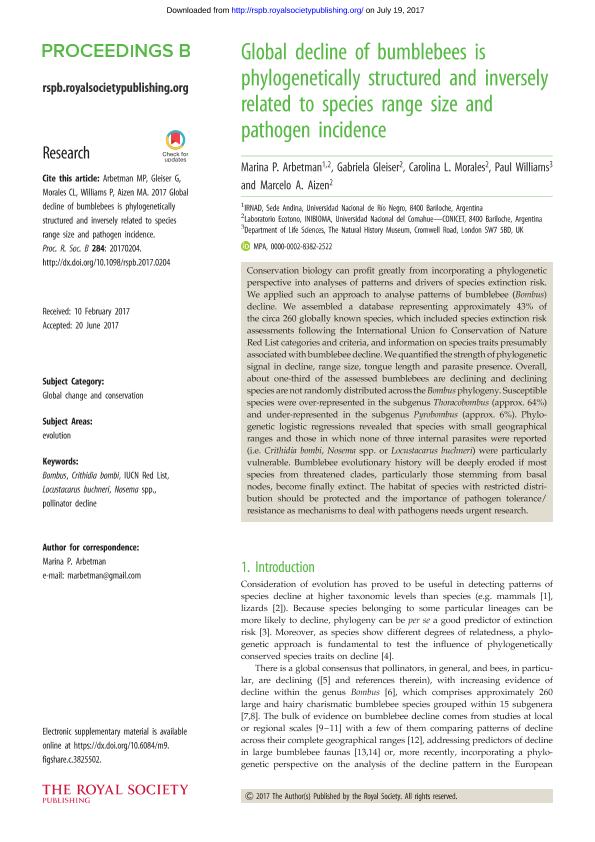Mostrar el registro sencillo del ítem
dc.contributor.author
Arbetman, Marina Paula

dc.contributor.author
Gleiser, Gabriela Laura

dc.contributor.author
Morales, Carolina Laura

dc.contributor.author
Williams, Paul
dc.contributor.author
Aizen, Marcelo Adrian

dc.date.available
2018-11-13T19:03:42Z
dc.date.issued
2017-07-19
dc.identifier.citation
Arbetman, Marina Paula; Gleiser, Gabriela Laura; Morales, Carolina Laura; Williams, Paul; Aizen, Marcelo Adrian; Global decline of bumblebees is phylogenetically structured and inversely related to species range size and pathogen incidence; The Royal Society; Proceedings of the Royal Society of London. Series B: Biological Sciences; 284; 1859; 19-7-2017; 1-8
dc.identifier.issn
0962-8452
dc.identifier.uri
http://hdl.handle.net/11336/64385
dc.description.abstract
Conservation biology can profit greatly from incorporating a phylogenetic perspective into analyses of patterns and drivers of species extinction risk. We applied such an approach to analyse patterns of bumblebee (Bombus) decline. We assembled a database representing approximately 43% of the circa 260 globally known species, which included species extinction risk assessments following the International Union fo Conservation of Nature Red List categories and criteria, and information on species traits presumably associated with bumblebee decline. We quantified the strength of phylogenetic signal in decline, range size, tongue length and parasite presence. Overall, about one-third of the assessed bumblebees are declining and declining species are not randomly distributed across the Bombus phylogeny. Susceptible species were over-represented in the subgenus Thoracobombus (approx. 64%) and under-represented in the subgenus Pyrobombus (approx. 6%). Phylogenetic logistic regressions revealed that species with small geographical ranges and those in which none of three internal parasites were reported (i.e. Crithidia bombi, Nosema spp. or Locustacarus buchneri) were particularly vulnerable. Bumblebee evolutionary history will be deeply eroded if most species from threatened clades, particularly those stemming from basal nodes, become finally extinct. The habitat of species with restricted distribution should be protected and the importance of pathogen tolerance/ resistance as mechanisms to deal with pathogens needs urgent research.
dc.format
application/pdf
dc.language.iso
eng
dc.publisher
The Royal Society

dc.rights
info:eu-repo/semantics/openAccess
dc.rights.uri
https://creativecommons.org/licenses/by-nc-sa/2.5/ar/
dc.subject
Bombus
dc.subject
Crithidia Bombi
dc.subject
Iucn Red List
dc.subject
Locustacarus Buchneri
dc.subject
Nosema Spp
dc.subject
Pollinator Decline
dc.subject.classification
Otras Ciencias Biológicas

dc.subject.classification
Ciencias Biológicas

dc.subject.classification
CIENCIAS NATURALES Y EXACTAS

dc.title
Global decline of bumblebees is phylogenetically structured and inversely related to species range size and pathogen incidence
dc.type
info:eu-repo/semantics/article
dc.type
info:ar-repo/semantics/artículo
dc.type
info:eu-repo/semantics/publishedVersion
dc.date.updated
2018-10-23T16:17:26Z
dc.journal.volume
284
dc.journal.number
1859
dc.journal.pagination
1-8
dc.journal.pais
Reino Unido

dc.journal.ciudad
Londres
dc.description.fil
Fil: Arbetman, Marina Paula. Consejo Nacional de Investigaciones Científicas y Técnicas. Centro Científico Tecnológico Conicet - Patagonia Norte. Instituto de Investigaciones en Biodiversidad y Medioambiente. Universidad Nacional del Comahue. Centro Regional Universidad Bariloche. Instituto de Investigaciones en Biodiversidad y Medioambiente; Argentina. Universidad Nacional de Río Negro; Argentina
dc.description.fil
Fil: Gleiser, Gabriela Laura. Consejo Nacional de Investigaciones Científicas y Técnicas. Centro Científico Tecnológico Conicet - Patagonia Norte. Instituto de Investigaciones en Biodiversidad y Medioambiente. Universidad Nacional del Comahue. Centro Regional Universidad Bariloche. Instituto de Investigaciones en Biodiversidad y Medioambiente; Argentina
dc.description.fil
Fil: Morales, Carolina Laura. Consejo Nacional de Investigaciones Científicas y Técnicas. Centro Científico Tecnológico Conicet - Patagonia Norte. Instituto de Investigaciones en Biodiversidad y Medioambiente. Universidad Nacional del Comahue. Centro Regional Universidad Bariloche. Instituto de Investigaciones en Biodiversidad y Medioambiente; Argentina
dc.description.fil
Fil: Williams, Paul. British Museum (natural History); Reino Unido
dc.description.fil
Fil: Aizen, Marcelo Adrian. Consejo Nacional de Investigaciones Científicas y Técnicas. Centro Científico Tecnológico Conicet - Patagonia Norte. Instituto de Investigaciones en Biodiversidad y Medioambiente. Universidad Nacional del Comahue. Centro Regional Universidad Bariloche. Instituto de Investigaciones en Biodiversidad y Medioambiente; Argentina
dc.journal.title
Proceedings of the Royal Society of London. Series B: Biological Sciences

dc.relation.alternativeid
info:eu-repo/semantics/altIdentifier/doi/http://dx.doi.org/10.1098/rspb.2017.0204
dc.relation.alternativeid
info:eu-repo/semantics/altIdentifier/url/http://rspb.royalsocietypublishing.org/content/284/1859/20170204
Archivos asociados
